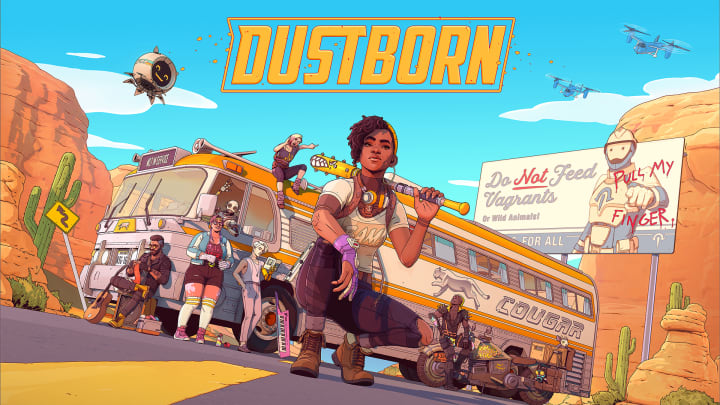Dustborn review: risking it all to get the word out

Indies are known for their innovation. With less pressure on them to succeed, they are able to push the envelope and discover a winning formula for triple-A games to snatch up years later. Innovation means risk, and risk is the main theme of Dustborn. It takes risks by mixing together a choices-matter narrative, rhythm, and action-adventure genres, with its timely, strongly political themes, and its unskippable fully-voiced dialogue. As with all risks, some of these pay off and others don’t.
At the heart of Dustborn is the narrative. Set in the near future, words have literal power. Certain members of the population have the gift of Vox, superpowers that come from their voices. Sai can turn her body to stone, Noam can convince you of anything, and our heroine Pax makes you feel bad. As only a limited amount of the population holds these powers they are persecuted; it’s basically the X-Men, except their suits aren’t as skin-tight.
The original four members of the gang steal data from a government on the power of words and are traveling in order to deliver the goods in an international espionage plot. This sees them go undercover as a band in a decked-out tour bus and play gigs across the continent to evade capture. They pick up more X-Men – or Anomals – along the way, and the meat of the game is in the choices you make and your relationships with the rest of the crew.
As with any narrative game, the strength of the characters is the most important aspect. There are more than 10 members in the main cast and with a crew this large it usually spells disaster. However, a lot of thought has gone into each character, they all feel different without clinging to tropes. The diversity of the characters certainly helps, as they all come from different backgrounds which will slowly be revealed to you as you progress through the story. Their experiences inform their characters in a way that feels natural.
The character development is bolstered by the dialogue style, which is particularly unique. Characters will interrupt, speak over each other, and they will hold conversations even when you aren’t in earshot. While Pax is the main character, they interact with each other beyond her and form realistic relationships. This style does have its downsides. Sometimes it's hard to get a feel for when it’s appropriate to butt in or end a conversation, and voices have a tendency to overlap each other. Sometimes characters can deliver two different lines at once. The voice acting is exemplary and it seems obvious the developers would want to showcase this, but it also means that you can’t skip lines leading to slow pacing in multiple sections.
Dustborn has gone for a comic book-style, so chapters, choices, and outcomes are summarized in gorgeous comic strips, and objectives are marked with comic-style text. This also feeds into the art direction as a whole, which not only helps to tie together the game thematically but also reminds us of Telltale’s excellent The Walking Dead series. Another similarity between the two is that your choices don’t matter as much as they might seem to. Much like how in The Walking Dead the characters you save are ultimately inconsequential, characters that come and go from your crew in Dustborn are scripted. The main differences that your choices make are in how each character reacts to you, and in the ending for each one.
The ending was also a sore spot for me. Without spoilers, it leans very heavily on a number of tropes, and doesn’t fit thematically with the rest of the game. It was an obvious meta-reference to how all of our words have power, and while this theme is timeless, a number of references won’t age well. The dialogue overall is extremely well written, but then you hear phrases like “woke mind virus” and “do your research” and your eyes will roll back. While these are well-known phrases now, they will undoubtedly age like milk.
I couldn’t figure out how to smoothly segue into discussing the combat and rhythm sections, but it feels appropriate to just shove it in here as this is how these elements feel in-game. Dustborn gives you the option to turn down the amount of combat, which is your first sign that it doesn’t really fit. You will use your words in combat, but you will also use an electrified baseball bat, and I know which one I relied on more. The rhythm section often comes out of nowhere, and while I appreciate that they tried to write original songs, to put it politely they were not to my taste.
Dustborn may be one of the most difficult games I’ve ever had to review. The core of the game, the characters and story, is one of the strongest I have seen since Telltale’s era, even if it fumbles towards the end. I love how dynamic and realistic the dialogue is, but hated what that did to the pacing. I adored the political message about speaking up for your beliefs, but wish it had been delivered with more subtlety and nuance. Dustborn makes missteps, but its victories more than compensate.
Score: 7/10
Version tested: PS5
